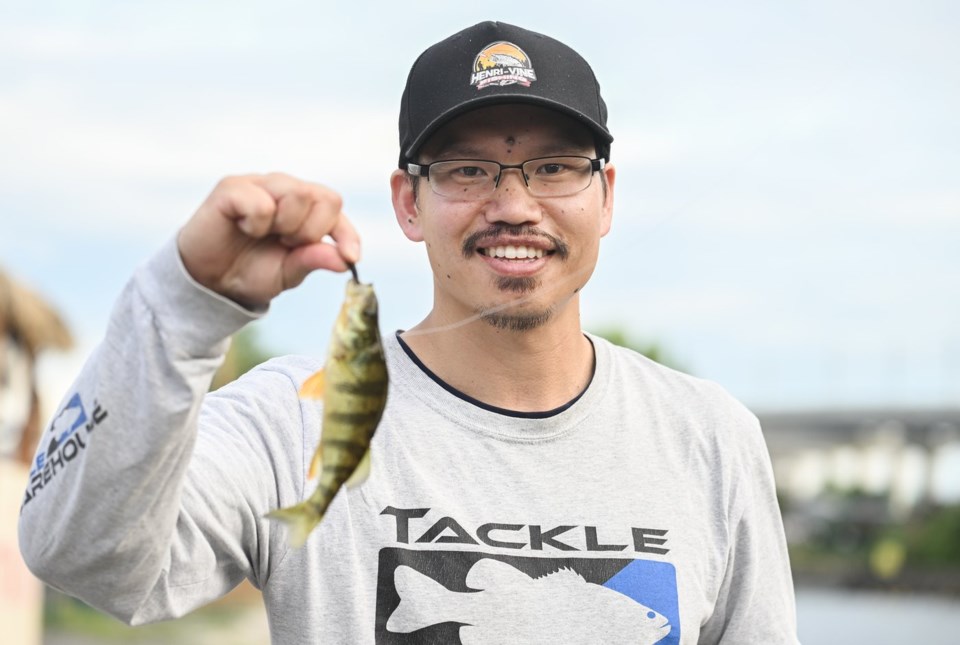MONTREAL — Live music pulses through the air as Henry Leung casts a lure into the murky waters of the Lachine Canal, at a site wedged between a noisy festival and the high-rises of Montreal's Griffintown neighbourhood.
It's no bucolic day on a lake, but Leung says there are plenty of fish to catch in heart of the city, ranging from bass and walleye to the large muskellunge — or muskie — which can grow to 125 centimetres long in these parts.
"It’s a really great activity for learning how to be patient," Leung said of fishing. "It’s not always going to happen, it’s not always going to work out, but if you put the time in it, eventually it will."
Leung is one of many urban fishers dropping a line into the Lachine Canal, undeterred by floating garbage, the roar of passing traffic or the layer of contaminated sediments at the bottom — a legacy of its industrial past.
Leung, who has been fishing since he was a child and runs a YouTube channel dedicated to the sport, says he has seen a "huge spike" in interest in fishing around Montreal that began in the early days of the COVID-19 pandemic, when lockdowns sent people looking for local outdoor activities.
He says the appeal of fishing in the canal is clear: it's close to home and takes only a $50 fishing rod and a $25 annual licence — as well as a little patience and practice.
"It’s not expensive and it’s something anyone can do," he said. "Anyone can go out and have fun."
Darian Savage, a Montreal-area fishing guide, says he has also seen "more and more people on the water" each year, especially young people. He credits not only COVID-19 but also the arrival of more immigrants from places where fishing is common.
While he prefers fishing on boats outside the city, he says the Lachine Canal connects to the St. Lawrence River, which explains the wide variety of fish species.
"If you were to show up to the Lachine Canal and find any spot along the shore and drop a worm in the bottom, I'm pretty sure you'd catch a fish pretty quickly," he said.
Parks saąúĽĘ´«Ă˝, which operates the Lachine Canal, says the site has been popular for fishing for many years because of its "its rich biodiversity and historical significance." It said it hadn't observed an increase in the number of anglers in recent months, but noted that its popular "Learn to fish" program always fills up fast.
On a recent fishing session, Leung quickly pulled a series of small, colourful perch from the water.
While three large carp could be seen lazing near the surface, the ones on the bottom he was trying to catch proved elusive. It could be the noise from festival, he said, or possibly the murky water from a recent 100-millimetre downpour of rain that exceeded sewer capacity and forced wastewater discharge into the canal.
Parks saąúĽĘ´«Ă˝ recommends consuming fish caught in the canal "in moderation" because of the layer of contaminated sediment on the bottom.
The 14-kilometre canal was once the cradle of the city's industrial development, with factories lining each side soon after its opening in 1825. It closed to shipping in 1970, after being rendered obsolete by the St. Lawrence Seaway.
While decontamination was discussed decades ago, an environmental report that preceded the canal's reopening for recreational activities in 2002 suggested that leaving the sediments in place would create less of an environmental impact.
"The safety of consuming fish from the Lachine Canal, as with any water body, depends on various factors, including pollution levels, contaminant concentrations, and advisories issued by health authorities," the agency said in a statement. It said advice on how much of a given species to eat could be found on the Quebec government's website, adding that fish caught in the canal would be similar to consuming fish caught in the St. Lawrence River.
Boats are limited to 10 kilometres an hour to avoid disturbing the sediment, and activities such as magnet fishing — a kind of underwater metal detecting — are forbidden.
A 2023 report by the City of Montreal indicated the Lachine Canal's waters ranged from "excellent" to "good" following water tests — despite the layer of highly contaminated sediment on the floor.
Leung says he does worry about the quality of the water — it's part of the reason he doesn't eat his catches; but his main concern is to avoid depleting the population.
Savage, for his part, isn't worried about the quality of the water, which he says looks worse than it is. He says he wouldn't hesitate to eat fish caught in the canal; though, like Leung, he prefers catch and release so they can still be caught another day.
This report by The Canadian Press was first published July 16, 2024.
Morgan Lowrie, The Canadian Press


